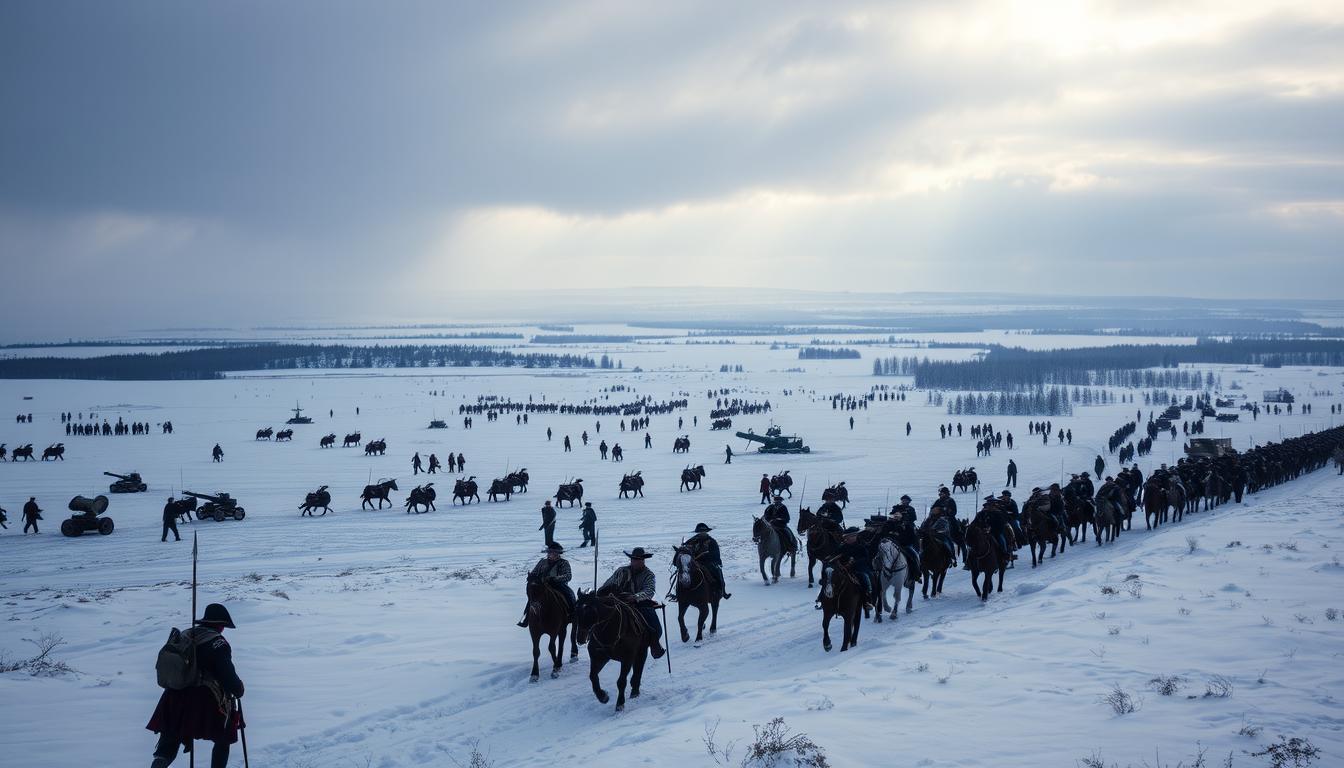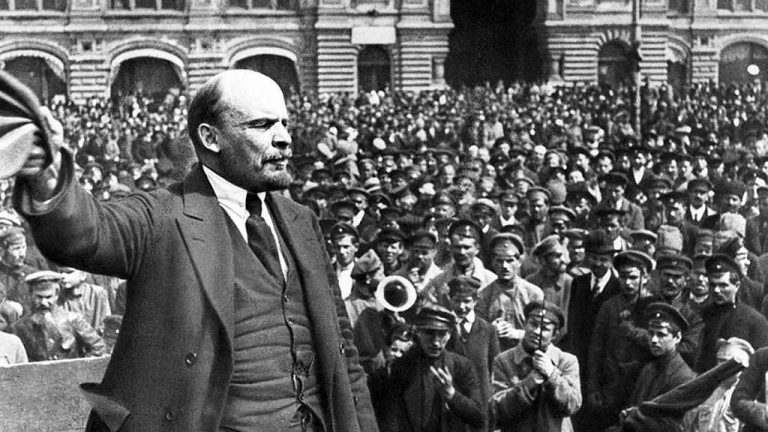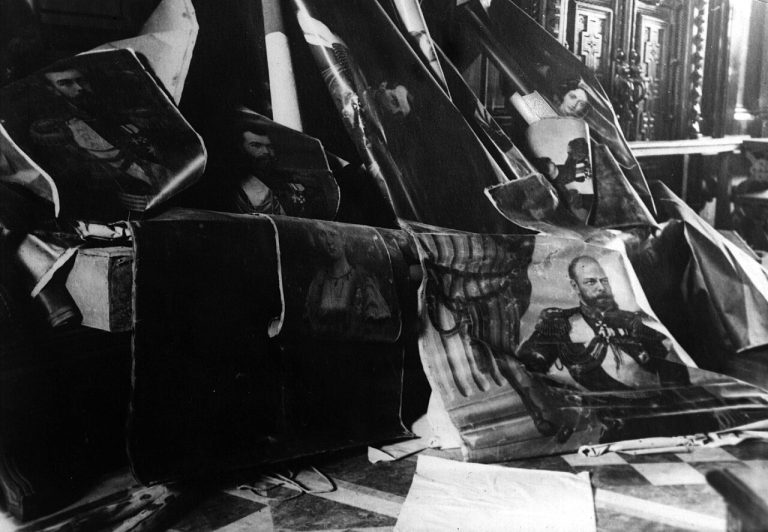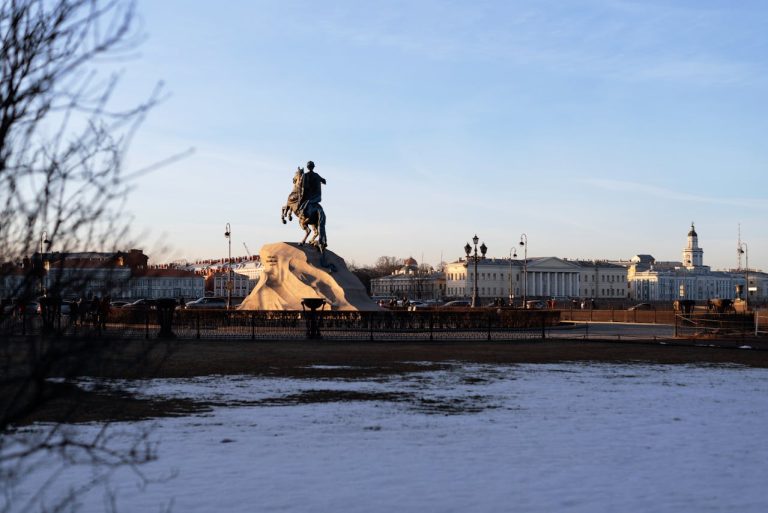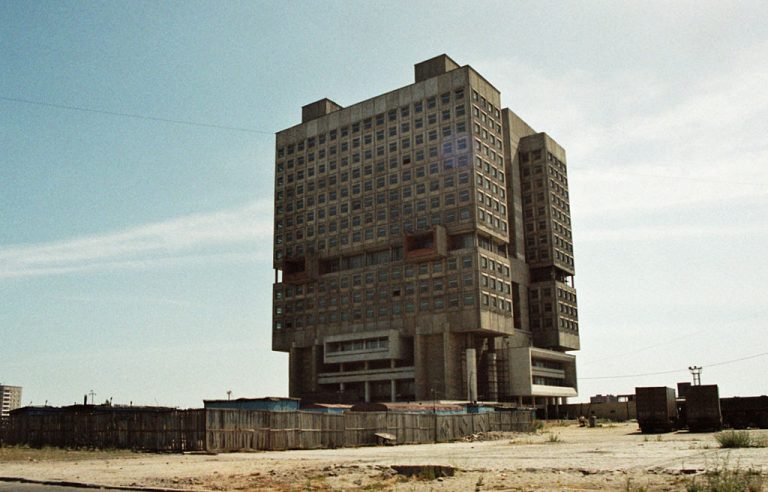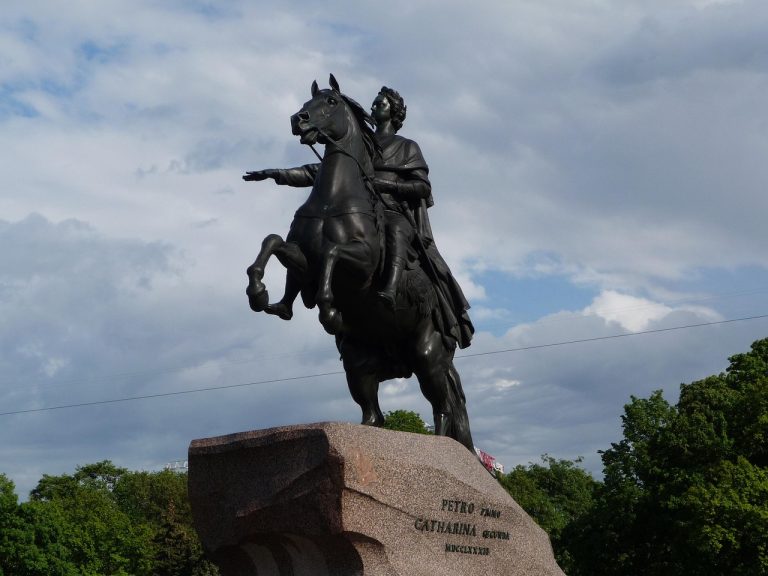In June 1812, Napoleon Bonaparte led the Grande Armée across the Neman River. Over 450,000 troops from France, Italy, and more marched into Belarus and western Russia. Their goal was to force Tsar Alexander I back into the Continental System against Britain.
The march was called the “Second Polish War.” It aimed to win Polish support and change the story of Napoleon’s Russian campaign. By September, French troops reached Moscow, but found fires, little food, and no peace talks.
The harsh weather and poor roads turned victory into defeat. Within six months, the army retreated back west, chased by Cossacks and peasants.
Both sides lost about one million soldiers and civilians. Napoleon’s defeat broke his image and changed Europe, leading to the Sixth Coalition. The question of why Napoleon invaded Russia is complex, involving politics, prestige, and Poland. Yet, the real lesson is how logistics and mistakes beat military skill.
Today, Napoleon’s invasion of Russia is a lesson in history. The harsh weather was a factor, but so were supplies, food for horses, and time. The campaign’s story, from the Neman crossing to the frozen retreat, continues to influence debates on Napoleon’s invasion of Russia and its impact on nineteenth-century Europe.
Setting the Stage: Europe on the Eve of the 1812 Russian Campaign
Europe was on high alert as empires eyed each other over trade and power. The Continental System made trade as important as armies. This set the stage for Napoleon’s invasion of Russia, a move that would shake the continent.
From Tilsit to Tension: How the 1807 Alliance Frayed
The Tilsit handshake seemed strong but soon fell apart. Napoleon and Alexander I had different goals. The Peninsular War distracted France, while Russia focused on its borders.
By 1809, distrust grew. France’s blockades hurt Russia, including the Duchy of Oldenburg, tied to Alexander’s family. This started Napoleon’s path to invade Russia quietly.
Continental System Pressures and Russia’s Economic Bind
Russia joined the Continental System but suffered. Its economy relied on exports, not factories. Without British buyers, Russia’s income dropped, making enforcement harder.
“Neutral” ships, like American ones, brought British goods into the Baltic. On December 31, 1810, Alexander I changed tariffs to favor imports, defying France. This move opened doors to British trade, pushing Napoleon to invade Russia.
Poland as a Geopolitical Fault Line: The Grand Duchy of Warsaw
The Grand Duchy of Warsaw was a wedge between France and Russia. It worried St. Petersburg, as it expanded into Western Galicia. This revived Poland worried Russia.
Envoys tried to calm tensions, but Napoleon kept Polish hopes alive. This hurt trust and raised the stakes in his Russian campaign. Poland’s history with Russia made this tension even more significant.
Austrian and Prussian Calculations Ahead of Invasion
In Vienna, Metternich played for time and advantage. Austria negotiated hard, considering Silesia and the Illyrian Provinces. By early 1812, it agreed to send troops to Napoleon’s right wing.
Prussia was squeezed but looked for a chance to change sides. Russia fought wars against the Ottomans and Persians, distracting it. This set the stage for Napoleon’s invasion, with strategy and politics playing big roles.
Tariffs, annexations, and Polish ambitions were all part of the mix. These factors set the stage for Napoleon’s Russian campaign in 1812, highlighting its historical importance.
Why Did Napoleon Invade Russia
In 1812, Paris asked a simple question: why did Napoleon invade Russia? The answer was complex, involving money, markets, and pride. Napoleon wanted to force Europe back into his system and prove French power.
Enforcing the Continental System Against Britain
Napoleon thought blocking British trade would make London negotiate. The Continental System was his plan, and Russia was key. Shutting ports to British goods seemed like a good idea at first.
By 1812, Napoleon worried the blockade was failing. He saw invading Russia as a way to fix the leaks. He believed it was about controlling trade and securing resources.
Russia’s Withdrawal From the Blockade and Tariff Ukase of December 1810
Emperor Alexander I changed course with the ukase of December 31, 1810. It allowed seaborne trade and taxed imports, favoring British goods. Napoleon saw this as a betrayal and a threat to his plans.
He believed this move hurt French exports and his reputation. This decision led to Napoleon’s failed invasion of Russia, seen as a quick fix at the time.
Securing Leverage via the “Second Polish War” Narrative
Poland was a bargaining chip without full promises. Calling the march the “Second Polish War” rallied support. Napoleon reassured Vienna that Poland wouldn’t fully return, keeping Austria in line.
This strategy allowed him to pressure St. Petersburg while keeping allies. It also gave a reason for the invasion that resonated with patriots in Poland.
Deterrence and Prestige: Restoring French Hegemony Amid the Peninsular War Drag
The Peninsular War was draining France, hurting morale and finances. A victory in the east could change the game. At Vilkaviškis in June 1812, Napoleon aimed to prove his power.
He hoped to shock the Russian armies, strengthen wavering allies, and restore French prestige. These goals, though, would ultimately be seen as the reasons for Napoleon’s failed invasion of Russia.
From Alliance to Rupture: Diplomatic Flashpoints That Triggered War
Cooperation turned to distrust after Tilsit. Letters flew back and forth, filled with warnings and disputes. These tensions set the stage for Napoleon’s Russian campaign, all without a single shot.
The Treaty of Schönbrunn and Western Galicia’s Transfer
The Treaty of Schönbrunn in 1809 moved Western Galicia to the Grand Duchy of Warsaw. St. Petersburg saw this as a French move to expand. This move raised fears of border changes and Napoleon’s intentions.
Oldenburg, the Baltic Ports, and Annexations That Angered St. Petersburg
France annexed Lübeck, Bremen, and Hamburg to strengthen the Continental System. In 1811, it took the Duchy of Oldenburg, upsetting Duke Peter, a relative of Alexander I. The offer of Erfurt as compensation was rejected, sparking public outrage.
Failed Assurances on Poland and Frayed Trust Between Courts
Envoys tried to limit a restored Polish state, but Napoleon refused. Pro-Polish sentiment and slogans fueled tensions. The gap between words and actions made Napoleon’s Russian campaign more likely, deepening the historical impact.
Chernyshev’s Intelligence Mission and the Spy Scandal in Paris
Colonel Alexander Chernyshev gathered French army data in Paris under diplomatic cover. His mission was exposed early in 1812, and he fled. His source, “Michel,” was caught and executed on May 1. By April, Alexander I demanded French troops leave Prussia and the Duchy of Warsaw. This ultimatum lit the fuse for Napoleon’s invasion of Russia.
The Grande Armée Marches East: Scale, Strategy, and Early Operations
The Grande Armée moved forward, leaving dust in its wake. Napoleon’s campaign against Russia started with speed and a large army. But, many wondered if he could win before winter arrived.
Napoleon’s army was diverse and his plan was bold. But, the vast lands of Lithuania and Belarus would test his strategy. He aimed for a quick victory and to send a message to Europe.
Crossing the Neman (June 24, 1812) and the Multinational Force
On June 24, 1812, the Grande Armée crossed the Neman River. Over 450,000 soldiers entered Russia, with a total of 685,000 troops involved. Soldiers came from many places, including France, Italy, and Prussia.
This diverse army was strong but faced challenges. Different languages and supply needs caused problems. The early days of the invasion showed the army’s power, but every step east made things harder.
Forced Marches Toward Smolensk and the Russian Strategic Retreat
Napoleon pushed his army hard, aiming to defeat the Russian armies. He wanted to split the Russian forces, which numbered 180,000–220,000. His plan needed speed and luck.
The Russians, led by Barclay de Tolly and Pyotr Bagration, retreated. They burned supplies and avoided battles. This strategy made the campaign a race against time and dwindling resources.
“Second Polish War” Proclamation to Rally Polish Support
Napoleon called the war the “Second Polish War” from Vilkaviškis. He hoped to win Polish support and rally Europe. But, the question of why he invaded Russia remained.
Polish towns supported Napoleon, but doubts lingered. The Grande Armée needed a quick victory to justify its actions. Time was running out.
Smolensk to Borodino: Tactical Gains, Strategic Uncertainty
Smolensk in August was a bloody battle. Napoleon won a tactical victory but not a strategic one. Mikhail Kutuzov then led the Russian retreat.
By September, the Grande Armée was weaker. At Borodino, they faced a smaller Russian army. The campaign was far from over, but the strain was evident.
Logistics Decide the Campaign: Why Plans Failed in Russia’s Vastness
Paper plans seemed perfect, but reality was different. The Russian campaign of napoleon needed food, wheels, and horses to move across a huge area. This was the main reason for napoleon’s failed invasion of Russia. It also raises a big question: why did napoleon invade Russia, and how did logistics ruin his plans?
Supply Lines From the Rhine to the Vistula: Magazines at Danzig, Vilna, Minsk
Napoleon invested in war supplies: twenty train battalions and 7,848 vehicles went from the Rhine to the Vistula. Danzig had food for 400,000 men for 50 days. Breslau, Płock, and Wyszogród made 60,000 biscuits a day for Thorn.
Vilna had rations for 100,000 men for 40 days, plus 27,000 muskets and 30,000 pairs of shoes. Depots were at Minsk, Vitebsk, Orsha, and Smolensk.
But distances made it hard to keep supplies flowing. Units at the front got what they needed, but those behind struggled. Even stores captured in Moscow couldn’t fix the thin supply lines.
Living Off the Land Meets Thin Populations and Scorched Earth
“Live off the land” worked in Central Europe. But in Lithuania and Russia, it was hard. Cossacks and scorched-earth tactics burned crops and villages.
Foragers often came back empty-handed. This left soldiers hungry. Wells were polluted, water was dangerous, and wagons were slow.
Horses, Roads, and Weather: Rasputitsa, Storms, and Traction Problems
Wagons made for German roads got stuck in Lithuanian mud. Rasputitsa turned tracks into mud, and summer heat made roads sharp. June storms flooded camps, and men lost boots in the mud.
Horses died from lack of food and exhaustion. Winter horseshoes were rare, making ice paths slippery. Without traction, guns and caissons couldn’t move.
Disease, Starvation, and Desertion Eclipse Battle Losses
Before winter, disease and hunger killed more than battles. Typhus and dysentery spread in crowded camps. Men at the back starved while those at the front fought for food.
Many deserted at night, seeking food or escape. These losses were greater than many battles. They also raised a question: did napoleon’s reasons for invading Russia match the risks? In the end, logistics were the main reason for failure.
Key Battles and Turning Points: Borodino, Moscow, and Maloyaroslavets
The Russian campaign of napoleon was marked by critical moments. Each step east seemed to promise a swift victory. Yet, each step back revealed the thinness of that promise. These moments highlight why napoleon’s invasion of Russia turned from a daring gamble to a slow undoing. They also show why the historical significance of napoleon invading Russia is so profound.
Borodino’s Brutal Stalemate and Kutuzov’s Decision at Fili
Borodino on September 7, 1812, saw over 250,000 soldiers clash in a single day. Roughly 70,000 were lost as the Grande Armée pushed forward but failed to break through the Russian lines. The battle was a draw, with no clear victor.
At Fili, Mikhail Kutuzov made a critical decision. He chose to save the army, not the city. This choice, though quiet and cold, kept Russia fighting and turned napoleon’s invasion into a war of endurance.
Moscow Occupied and Ablaze; No Russian Peace Overture
Napoleon entered Moscow on September 14 to find a city in ruins. Fires, set by Governor Fyodor Rostopchin, ravaged the wooden quarters. The throne room was silent, as Emperor Alexander I refused to negotiate.
Five weeks in the ashes brought no advantage, only hunger and doubt. The invasion’s historical significance grew here: a capital held without consent was worthless in war.
Maloyaroslavets Blocks a Fresh Route; the Forced Retreat
Turning southwest toward Kaluga seemed to offer supplies and a new path. But at Maloyaroslavets in October, Kutuzov’s defense blocked this route. The road ahead was closed, and the road back to Smolensk was bare.
Winter arrived early. With no forage and failing horses, napoleon’s invasion began to unravel in snow and broken wagons.
Krasnoi and the Berezina: Catastrophic Retreat Under Pressure
Near Krasnoi, the Old Guard fought through ice and fire to clear paths for retreating troops. Cavalry and guns, lacking horses, lagged behind. The retreat became a series of rescues under fire.
By late November at the Berezina, around 49,000 troops and 40,000 stragglers clung to the main body. The river crossing saved a small remnant at great cost. This marked the end of napoleon’s invasion of Russia, highlighting its historical significance.
| Battle/Turning Point | Date & Location | What Happened | Strategic Outcome | Relevance to napoleon’s failed invasion of Russia |
|---|---|---|---|---|
| Borodino | Sept 7, 1812; west of Moscow | Bloodiest day; ~70,000 casualties; no decisive rout | Tactical edge without strategic breakthrough | Momentum stalled early, weakening napoleon’s invasion of Russia |
| Fili Council | Sept 13, 1812; near Moscow | Kutuzov preserved the army over the city | Enabled continued Russian operations | Set conditions for the drawn-out retreat |
| Moscow Occupation | Sept–Oct 1812; Moscow | City burned; Alexander I refused peace | No political gain from holding the capital | Exposed the historical significance of napoleon invading Russia: cities without surrender do not end wars |
| Maloyaroslavets | Oct 1812; Kaluga axis | Russian stand blocked the southern route | Forced return to the devastated Smolensk road | Locked the retreat onto barren ground |
| Krasnoi | Nov 1812; west of Smolensk | Old Guard opened paths for retreating corps | Heavy losses under snow and constant attack | Showed the army’s collapse in real time |
| Berezina Crossing | Late Nov 1812; Belarus | Desperate bridgework saved a remnant | Escape at severe cost, with shattered cohesion | Final, stark proof of napoleon’s failed invasion of Russia |
Consequences of Napoleon Invading Russia for Europe and Russia
The Russian campaign of napoleon shattered the confidence that had driven French victories. The invasion’s effects were felt in courts, barracks, and markets across Europe. It changed how Europe views power, distance, and determination.
Napoleon’s Reputation Shattered; French Hegemony Weakened
Victories like Austerlitz and Wagram made Napoleon seem unstoppable. But the retreat from Moscow shattered that image. Officers started talking about limits, mud, and hunger instead of speed and surprise.
Paris felt the shock. Financial troubles grew, conscription increased, and allies became cautious. The invasion showed Europe that Napoleon could be defeated.
Prussia and Austria Pivot, Paving the Way to the Sixth Coalition
In Berlin, leaders like Gerhard von Scharnhorst and August von Gneisenau saw an opportunity. Prussia turned from a forced ally to a determined enemy. Vienna, led by Klemens von Metternich, followed with bold steps.
This shift brought Britain, Russia, Prussia, and Austria together. They formed the Sixth Coalition, setting the stage for the Battle of Leipzig in 1813 and the march to Paris.
Human Toll: One Million Military and Civilian Deaths
Numbers paint a grim picture. About 380,000 soldiers from the French side died, with disease claiming half. Russian losses were also huge, and when civilians are included, deaths neared one million.
Cold weather played a part, but hunger and disease were the main causes. The campaign became a symbol of massive loss across Europe.
| Dimension | France and Allies | Russian Empire | European Effect |
|---|---|---|---|
| Forces Engaged | Over 600,000 at the start, multinational | Hundreds of thousands across multiple armies | Mobilization strained states from the Rhine to the Baltic |
| Losses | Approx. 380,000 dead; disease a major share | Hundreds of thousands military and civilian | Overall deaths approached one million |
| Logistics | Overlong supply lines, collapsing depots | Scorched earth denied resources | War economies recalibrated across Europe |
| Political Outcome | Hegemony weakened; aura broken | Confidence boosted, borders defended | Sixth Coalition formed and gathered momentum |
| Memory | End of invincibility myth | “Patriotic War of 1812” as a national touchstone | Model for coalition warfare against domination |
Impact of Napoleon’s Invasion on Russia: Mobilization, Scorched Earth, and National Memory
Russia adopted a strategy of depth. Michael Kutuzov’s retreats and the stand at Borodino taught a lesson: stretch the enemy, then let time and attrition do the rest.
Local efforts grew. Serfs, nobles, and merchants joined militias and raised funds. The “Patriotic War of 1812” became a cultural touchstone, remembered in art by Pyotr Tchaikovsky and literature by Leo Tolstoy.
The invasion’s effects reshaped Russia’s policies and pride. Even before the worst of the winter, the campaign’s harsh conditions became symbols. This blend highlights the campaign’s lasting impact on strategy and identity.
Conclusion
Why did Napoleon invade Russia? It was about power and pressure. He wanted to stop Britain’s trade and punish Russia for breaking a trade agreement. He also sought to regain honor during the long Peninsular War.
He moved quickly, calling it the “Second Polish War.” But his plan fell apart on the journey. The roads turned to mud and ice, causing delays and losses.
At Borodino, both armies suffered heavy losses without a clear victory. Moscow was burned, but peace didn’t come. The retreat was disastrous, with many casualties.
The invasion’s effects went beyond Russia. It led Prussia and Austria to join forces against Napoleon. His power began to fade, and his reputation suffered.
The human toll was immense, affecting soldiers and civilians. The invasion left scars from Smolensk to the Niemen.
The lesson from Napoleon’s invasion is clear. Strategy must rely on solid supply lines, not just hope. Maps can’t show the true distance of muddy roads. When an enemy avoids battles, speed becomes a liability. In 1812, Napoleon’s ambition outpaced his logistics, changing Europe’s course.
FAQ
Why Did Napoleon Invade Russia in 1812?
Napoleon wanted to force Tsar Alexander I back into the Continental System. This was to hurt Britain. Russia had changed its trade rules, favoring sea trade over land, which upset Napoleon.
He also wanted to show his power. The war in Spain was draining resources. He hoped to win quickly and show his strength again.
What Sparked the Breakdown After Tilsit?
The partnership between France and Russia started to break down. Russia’s economy was suffering under the blockade. The rules were not being enforced well.
Napoleon had taken over some areas, which upset Russia. The rise of Poland also made Russia wary. Napoleon’s promises on Poland were not trusted.
How Big Was Napoleon’s Army and Who Joined the Invasion?
The first wave of Napoleon’s army had over 450,000 soldiers. They came from France, Poland, Italy, and other places. In total, about 685,000 soldiers were involved in the Russian campaign.
Why Did Napoleon’s Invasion of Russia Fail?
The invasion failed due to many reasons. The roads were bad, and the wagons got stuck. The army had to forage for food, but this was hard.
Horses died because of lack of food. Many soldiers got sick or deserted. Russia used guerrilla tactics to slow down the French army.
What Happened at Borodino and Why Was Moscow Not the End?
The Battle of Borodino on September 7, 1812 was a bloody draw. Napoleon then took Moscow, but it was largely destroyed. The Tsar refused to make peace.
After five weeks, Napoleon tried to leave Moscow. But the road was blocked, and he had to retreat through a devastated area.
What Were the Consequences of Napoleon Invading Russia?
Napoleon’s invasion made him look weak. Prussia and Austria turned against him. The war killed hundreds of thousands of soldiers and civilians.
France’s power in Europe began to decline.
What Was the Impact of Napoleon’s Invasion on Russia?
The invasion showed the value of strategic depth and attrition. It made Mikhail Kutuzov a hero in Russia. It also made Russia more determined to defend itself.
The “Patriotic War of 1812” became a key part of Russian history. It taught Russia how to fight against foreign invaders.
How Did Poland Figure Into Napoleon’s Plans?
Napoleon used Poland to pressure Russia. He created the Grand Duchy of Warsaw to support his plans. But he didn’t promise to fully restore Poland.
This made Russia suspicious and helped push them towards war with France.
What Role Did Intelligence and Diplomacy Play Before the Invasion?
Intelligence and diplomacy were key before the invasion. Colonel Alexander Chernyshev gathered information for Napoleon. But his efforts were discovered in early 1812.
There were also diplomatic tensions. Alexander’s ultimatum in April demanded French troops leave certain areas. This showed the alliance was breaking down.
Why Are Krasnoi and the Berezina Remembered?
Krasnoi and the Berezina are remembered for the disaster of the retreat. At Krasnoi, Napoleon used his elite troops to try and escape. The crossing of the Berezina River in late November saved some soldiers but was very costly.
These events symbolized the failure of the campaign.
